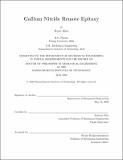| dc.contributor.advisor | Kim, Jeehwan | |
| dc.contributor.author | Qiao, Kuan | |
| dc.date.accessioned | 2022-08-29T16:24:07Z | |
| dc.date.available | 2022-08-29T16:24:07Z | |
| dc.date.issued | 2022-05 | |
| dc.date.submitted | 2022-06-23T15:04:31.734Z | |
| dc.identifier.uri | https://hdl.handle.net/1721.1/144966 | |
| dc.description.abstract | Silicon-based electronics devices and integrated circuits have been the backbone of most modern technology, the demands for smaller and faster electronics have pushed the material towards its physical limitations. Compound semiconductor materials are growing in importance because of their ability to offer superior performance across a wide range of applications in optoelectronics and power electronics. Unfortunately, the adoption of these new materials has been hindered by the lack of cost-effective epitaxial substrates and the difficulties in integrating with existing processes. Additionally, the rigid wafers pose major challenges to future flexible electronics and the heterogeneous integration of dissimilar materials.
To overcome these limitations, a new layer transfer technology based on remote epitaxy is developed. Remote epitaxy takes advantage of the atomic thickness of the two-dimensional (2D) material so that the wafer covered by 2D material can still be the substrate for epitaxial growth. At the same time, the weak van der Waals interaction between the 2D material and the epitaxial layer allows the epitaxial layer to be mechanically exfoliated precisely at the 2D material interface. In this work, the mechanism of remote epitaxy is systematically investigated. This work demonstrates that the strength of remote interaction between the substrate and epitaxial layer through 2D material is determined by the ionicity of the bulk materials and the thickness of the 2D interlayer. The 2D interlayer is transparent to such remote interaction unless it possesses periodic polar bonds.
The remote epitaxy of gallium nitride (GaN) is studied in depth. Freestanding GaN thin film with a threading dislocation density of 2.1×10⁷ cm⁻² and electron mobility of 254 cm²/(V·s) is demonstrated. The thin film is then transferred onto a host substrate and the original substrate can be reused without refurbishment. The process demonstrated in this work can significantly reduce the production cost of compound semiconductor devices by reusing the expensive wafers. The free-standing crystalline thin films obtained by remote epitaxy can also be monolithically integrated to accommodate existing processes or create novel heterogeneous structures. | |
| dc.publisher | Massachusetts Institute of Technology | |
| dc.rights | In Copyright - Educational Use Permitted | |
| dc.rights | Copyright MIT | |
| dc.rights.uri | http://rightsstatements.org/page/InC-EDU/1.0/ | |
| dc.title | Gallium Nitride Remote Epitaxy | |
| dc.type | Thesis | |
| dc.description.degree | Ph.D. | |
| dc.contributor.department | Massachusetts Institute of Technology. Department of Mechanical Engineering | |
| dc.identifier.orcid | https://orcid.org/0000-0002-0601-1873 | |
| mit.thesis.degree | Doctoral | |
| thesis.degree.name | Doctor of Philosophy | |
